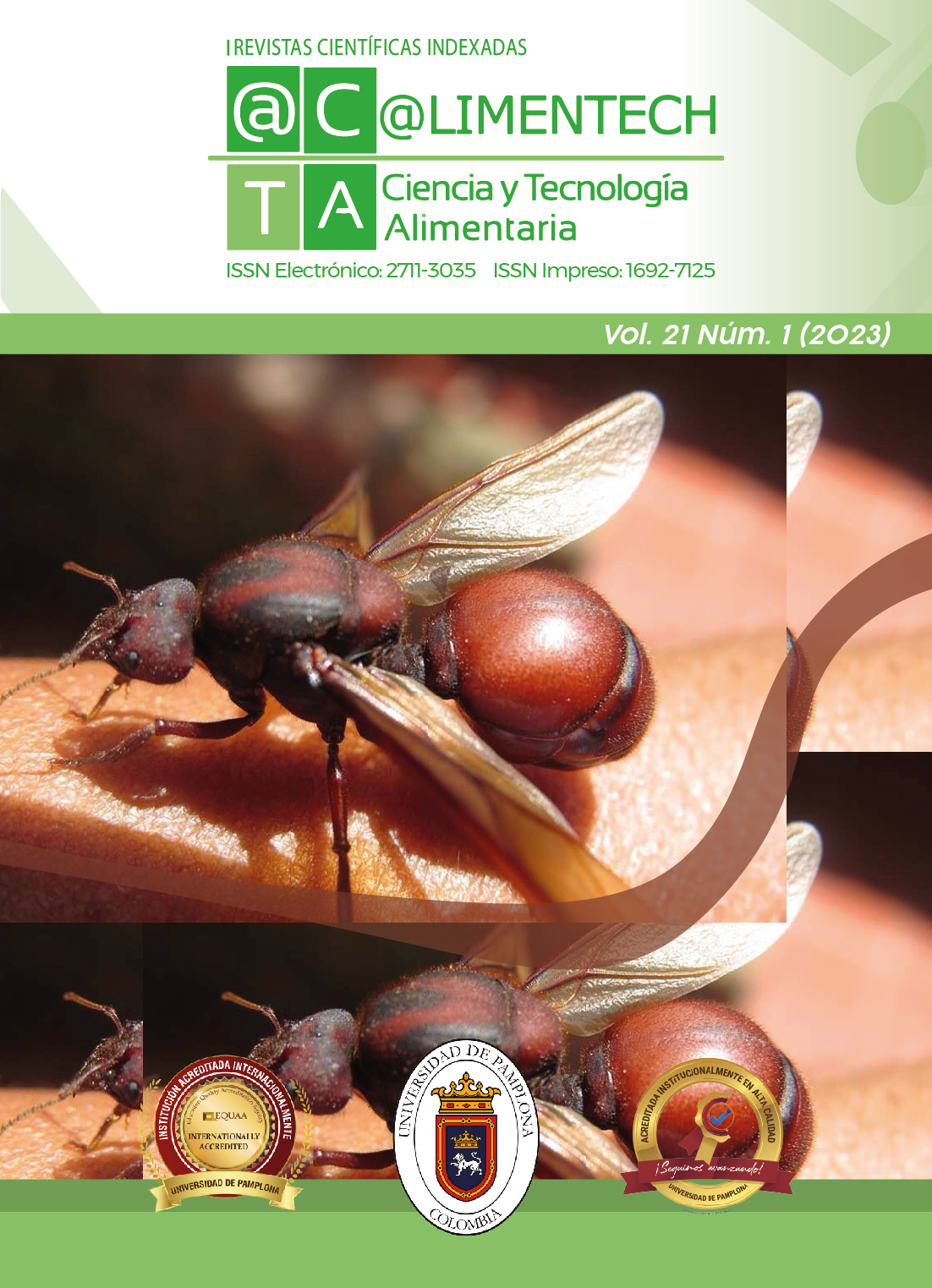Guinda (pronus ceresus) como fuente de moléculas bioactivas
DOI:
https://doi.org/10.24054/limentech.v21i1.2365Palabras clave:
Actividad biológica, frutas, guinda metabolitos bioactivosResumen
La naturaleza nos provee una innumerable variedad de especies vegetales frutales como la guinda (Pronus ceresus) con sugestivas propiedades biológicas que contribuyen a una importante fuente de nuevas moléculas bioactivas, que además de ser menos toxicas, son capaces de sustituir a los químicos sintéticos, los cuales resultan nocivos para el medio ambiente. Actualmente existe cierta cantidad de publicaciones en las que la guinda está relacionada con actividad biológica, según la búsqueda realizada en diferentes bases de datos hasta agosto de 2022. Lo anterior constata la gran utilidad de esta fruta como fuente primordial de metabolitos bioactivos, que pueden ser utilizados como principios activos en diferentes productos de gran provecho para la humanidad.
Descargas
Referencias
A. Cano, M.B. Arnao. "Actividad Antioxidante Hidrofílica y Lipofílica y contenido en vitamina C de zumos de Naranja comerciales; Relación con sus características organolépticas". (2004). "Ciencia y tecnología Alimentaria". Sociedad Mexicana de Nutrición y Tecnología de Alimentos, Reynosa, México. vol 4(3): 185-189.
A. Gutiérrez & L. Ledesma. "Capacidad antioxidante total de alimentos convencionales y regionales de Chiapas, México". (2007). Revista Cubana de la Salud Pública, La Habana, Cuba.
D.O. Kim, H.J. Heo, Y.J. Kim, H.S. Yang & C.Y. Lee. Sweet and sour cherry phenolics and their protective effects on neuronal cells. (2005). Journal of Agricultural and Food Chemistry, vol 53(26): 9921–9927.
D.J.S. Price. Little Science, big science and beyond. (1986).
F. Blando, C. Gerardi & I. Nicoletti. Sour cherry (Prunus cerasus L.) anthocyanins as ingredients for functional foods. (2004). BioMed Research International, vol (5): 253–258.
F.A. Saleh, N. El-Darra, K. Raafat. Hypoglycemic effects of Prunus cerasus L. pulp and seed extracts on Alloxan-Induced Diabetic Mice with histopathological evaluation. (2017). Biomedicine & Pharmacotherapy, vol (88): 870–877.
G. Villarroel, L. Artica. Determinación de la actividad antioxidante de la guinda (Prunus capuli). (2008). Universidad Nacional Del Centro Del Perú, Huancayo, Perú.
G.R. Sadani, G.D. Nadkarni. Role of tissue antioxidant defence in thyroid cancers. (1996). Cancer Letters, vol 109(1-2): 231-235.
G. Toydemir, E. Capanoglu, M.V. Gomez, R.C.H. de Vos, D. Boyacioglu, R.D. Hall, J. Beekwilder. Industrial processing effects on phenolic compounds in sour cherry (Prunus cerasus L.) fruit. (2013). Food Research International, vol (53): 218–225.
J. Contreras, L. Calderón, E. Guerra, B. García. Antioxidant capacity, phenolic content and vitamin C in pulp, peel and seed from 24 exotic fruits from Colombia. (2010). Food Research International, In Press, Corrected Proof.
J. Scalzo, A. Politi, N. Pellegrini, B. Mezzetti, M. Battino. Plant genotype affects total antioxidant capacity and phenolic contents in fruit. Nutrition. (2005). vol 21(2): 207-213.
S. Wang, J.P. Melnyk, R. Tsao, M.F. Marcone. How natural dietary antioxidants in fruits, vegetables and legumes promote vascular health. (2011). Food Research International, vol 44(1): 14-22.
Z. Veres, I. Holb, J. Nyéki, Z. Szabó, J. Remenyik & M.G. Fári. High antioxidant – and anthocyanin contents of sour cherry cultivars may benefit the human health: international and Hungarian achievements on phytochemicals. (2006). International Journal of Horticultural Science, vol 12(3): 45–47.
Descargas
Publicado
Número
Sección
Licencia
Derechos de autor 2023 @limentech, Ciencia y Tecnología Alimentaria

Esta obra está bajo una licencia internacional Creative Commons Atribución-NoComercial 4.0.








